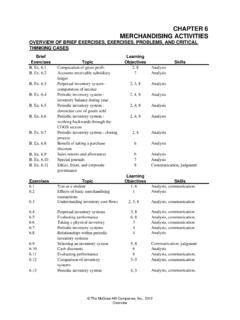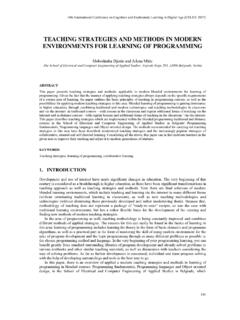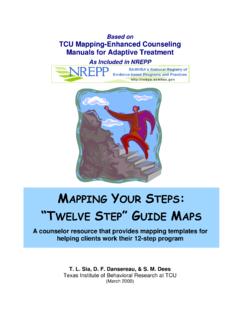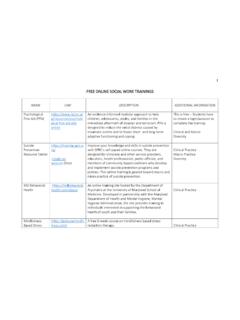Transcription of CHAPTER 4 THE ACCOUNTING CYCLE: ACCRUALS AND …
1 BriefExercisesB. Ex. Ex. Ex. Ex. Ex. Ex. Ex. Ex. Ex. Ex. 6, expenses and , 2, and deferrals1-6, payable and interest1, 2, 7, , 3 5, , 4, 7 Deferred 7, of adjusting entries1 , 2 3 TopicObjectivesDeferred expenses and revenue5 overview OF brief EXERCISES, EXERCISES, PROBLEMS, AND CRITICAL THINKING CASESL earningSkillsAccrued interest5 Unearned revenue4 Accrued salaries5 CHAPTER 4 THE ACCOUNTING CYCLE: ACCRUALS AND DEFERRALSE xercises6 AnalysisAnalysisAnalysisAnalysisAccrued taxesAnalysisAnalysisAnalyzing the adjusted trial balanceReal World: Home Depot Using an annual reportAdjustments and the balance sheetAnalysisCommunication, analysisAccounting principlesAnalysisAccounting for suppliesAnalysisAccounting for depreciation3 Accrued revenue3, 4 AnalysisDeferred expenses and revenue3, 4 AnalysisConcept of materialityInterpreting business transactions8 Deferred expenses and revenueReal World: Various firmsSkillsAnalysis, judgmentCommunication, analysisAnalysis, judgmentCommunication, analysis, judgmentJudgment, communication, analysisTopicDeferred revenueReal World: American Airlines Effects of adjusting entriesAccounting terminologyAnalysis The McGraw-Hill Companies, Inc.
2 , 2012 OverviewProblemsLearningSets A, A, A,B1 6, A,BAnalysis of adjusted data1 7, A,B1 7, A,B1 7, A,BPreparing and analyzing adjusting entries1 7, A,BPreparing and analyzing adjusting entries1 7, A,B1 7, 1 World: Avis 8 The concept of 3, 7, involved in adjusting 1 6 Analysis, communicationAnalysis, communicationSkillsCritical Thinking CasesReal World: Hershey IdentifyingDetermining whether adjusting entries are requiredTopicPreparing and analyzing adjusting entriesCommunication, technology, judgment, researchAnalysis, communicationAnalysis, communicationAnalysis, judgment, communicationCommunication, judgment, analysisAnalysis, judgment, communicationAnalysisPreparing and analyzing adjusting entriesAnalysis, communicationAnalyzing the effects of errorsPreparing and analyzing adjusting entriesAnalysis, communication process (Internet)Expense Manipulation (Ethics, fraud & corporate governance)Preparing and analyzing adjusting entriesAnalysis The McGraw-Hill Companies, Inc.
3 , 2012 OverviewDESCRIPTIONS OF PROBLEMS AND CRITICAL THINKING CASESP roblems (Sets A and B) A,B20 A,B40 A,B25 A, A,B30 A,B30 MediumRequires students to prepare adjusting entries and interpret financial are brief descriptions of each problem and case. These descriptions are accompanied by the estimated time (in minutes) required for completion and by a difficulty rating. The time estimates assume use of the partially filled-in working MediumCampus Theater/Off-Campus PlayhouseRequires students to prepare adjusting entries, analyze financial information, and interpret differences between income taxes expense and income taxes Adventures/River RatRequires students to prepare adjusting entries, classify them as ACCRUALS or deferrals, and discuss the difference between the book value of an asset and its fair market students to prepare adjusting entries, classify them as ACCRUALS or deferrals, analyze their effects on the financial statements.
4 And report assets at book value in the balance Palms Country Club/Georgia Gun ClubEnchanted Forest/Big OaksTerrific Temps/Marvelous Music Requires students to prepare adjusting entries and determine amounts reported in the financial Expeditions/Mate Ease Requires students to prepare adjusting entries, determine amounts reported in the financial statements, and interpret certain deferrals. The McGraw-Hill Companies, Inc., 2012 overview and Desc. of CasesProblems (continued)Ken Hensley Enterprises, Investigations60 StrongRequires students to journalize adjusting entries, prepare an adjusted trial balance, and understand various relationships among financial statement Corporation/Stephen CorporationRequires students to analyze the effects of errors on financial statement Thinking CasesJudgments and Year-End Adjustments The Concept of Materiality Expense Manipulation Ethics, Fraud & Corporate Governance Identifying Accounts Internet A, A,B20 StrongStudents are asked to identify accounts in Hershey s balance sheet that were most likely to have been involved in the company s year-end adjusting entry EasyRequires students to exercise judgment regarding the need for adjusting the concept of materiality.
5 The purchase of automobiles by Avis for its rental fleet is used to illustrate how the cumulative effect of many immaterial transactions can become must determine whether the capitalization of advertising expenditures was in compliance with generally accepted ACCOUNTING principles, and whether the decision to do so was Easy The McGraw-Hill Companies, Inc., 2012 Desc. of Prob & CasesSUGGESTED ANSWERS TO DISCUSSION purpose of making adjusting entries is to recognize certain revenue and expenses that are not properly measured in the course of recording daily business transactions. These entries help achieve the goals of accrual ACCOUNTING by recognizing revenue when it is earned and recognizing expenses when the related goods or services are adjusting entries affect both an income statement account and a balance sheet account. Every adjusting entry involves the recognition of either revenue or expense.
6 Revenue and expenses represent changes in owners equity, which appears in the balance sheet. However, owners equity cannot change by itself; there must also be a corresponding change in either assets or adjusting entries requires a better understanding of accrual ACCOUNTING than does the recording of routine business transactions because there is no "external evidence" (such as bills or invoices) indicating the need for adjusting entries. Adjusting entries are necessary to reflect recorded costs that have expired and recorded revenue that has been earned or to recognize previously unrecorded business activities. Thus, the need for adjusting entries is determined by the accountant s understanding of the concepts of accrual ACCOUNTING , not by external source accrual ACCOUNTING , an expense is defined as the cost of goods and services used in the effort to generate revenue.
7 Thus, an expense is incurred when the related goods and services are used, not when the expense is paid. A 12-month insurance policy represents insurance coverage that is used up over a 12-month period. The cost of such a policy should be debited to an asset account and gradually recognized as an expense over the 12 months that the policy is in ACCOUNTING requires that revenue be recognized in the ACCOUNTING records when it is earned. If revenue has been earned, but not yet recorded in the accounts, an adjusting entry should be made to include this revenue in the income of the current period. This entry will credit a revenue account; as the revenue has not yet been collected, the debit will be to an account term, unearned revenue, describes amounts that have been collected from customers in advance and that have not yet been earned. As the company has an obligation to render services to these customers or to refund their advance payments, unearned revenue appears in the liability section of the balance sheet.
8 As services are performed for these customers, the liability is reduced. Therefore, an adjusting entry is made transferring the balance of the unearned revenue account into a revenue account. The McGraw-Hill Companies, Inc., but unpaid expenses are reported in the balance sheet as liabilities. They include items such as salaries payable, interest payable, and taxes but uncollected revenue is reported in the balance sheet as accounts Corporation accounts for customer deposits as deferred, or unearned, revenue. As travelers pay for their cruises in advance, Carnival debits Cash and credits Customer Deposits (a liability account). As cruises take place, Carnival debits Customer Deposits and credits Cruise Revenue refers to the relative importance of an item or an event to the users of financial statements. An item is material if knowledge of it might reasonably influence the decisions of financial statement an item is not material, by definition it is not relevant to decision makers.
9 Therefore, the item may be treated in the most convenient and economical manner by the preparer of the financial statements. Thus, the concept of materiality permits departures from other generally accepted ACCOUNTING principles in ACCOUNTING for items that are not revenue (also referred to as unearned revenue or customer deposits) is reported in the balance sheet as a realization principle governs the timing of revenue recognition. The principle states that revenue should be recognized (reported in the income statement) in the period in which it is earned. This does not necessarily coincide with cash flow, however. Cash can be received from customers in a period before revenue is earned or in a period after revenue is $1,000 expenditure is not considered material to all businesses. Most large enterprises round the dollar amounts shown in their financial statements to the nearest $1 thousand or nearest $1 expenses are those assets reported in the balance sheet that will later become expenses reported in the income statement.
10 They include, but are not limited to, office supplies, prepared rent, prepaid insurance, buildings, equipment, matching principle governs the manner in which revenue is offset by the expenses incurred in producing that revenue. Generally, expenses are matched to revenue in the periods that resources are consumed in generating revenue earned. Expense recognition does not necessarily coincide with the payment of cash. The McGraw-Hill Companies, Inc., 2012Q7-15B. Ex. a. Nov. 30500 Unexpired Insurance ..500b. Nov. 30500 Premium Revenue 500B. Ex. a. Feb. 28175 Prepaid Rent .. 175To record February rent of $ Feb. 28175 Rent Revenue Earned .. 175B. Ex. 311,100 Office 1,100B. Ex. a. Dec. 31750 Accumulated Depreciation: Equipment .. 750b. B. Ex. ,340 Client Service Revenue .. 3,340#4067 10 $85 $ 850#3940 14 $75 1,050#1852 16 $90 1,440 $ 3,340 The equipment's accumulated depreciation reported in thebalance sheet on December 31, 2011, is $54,000 ($72,000 8-year life x 6 years of depreciation = $54,000).





